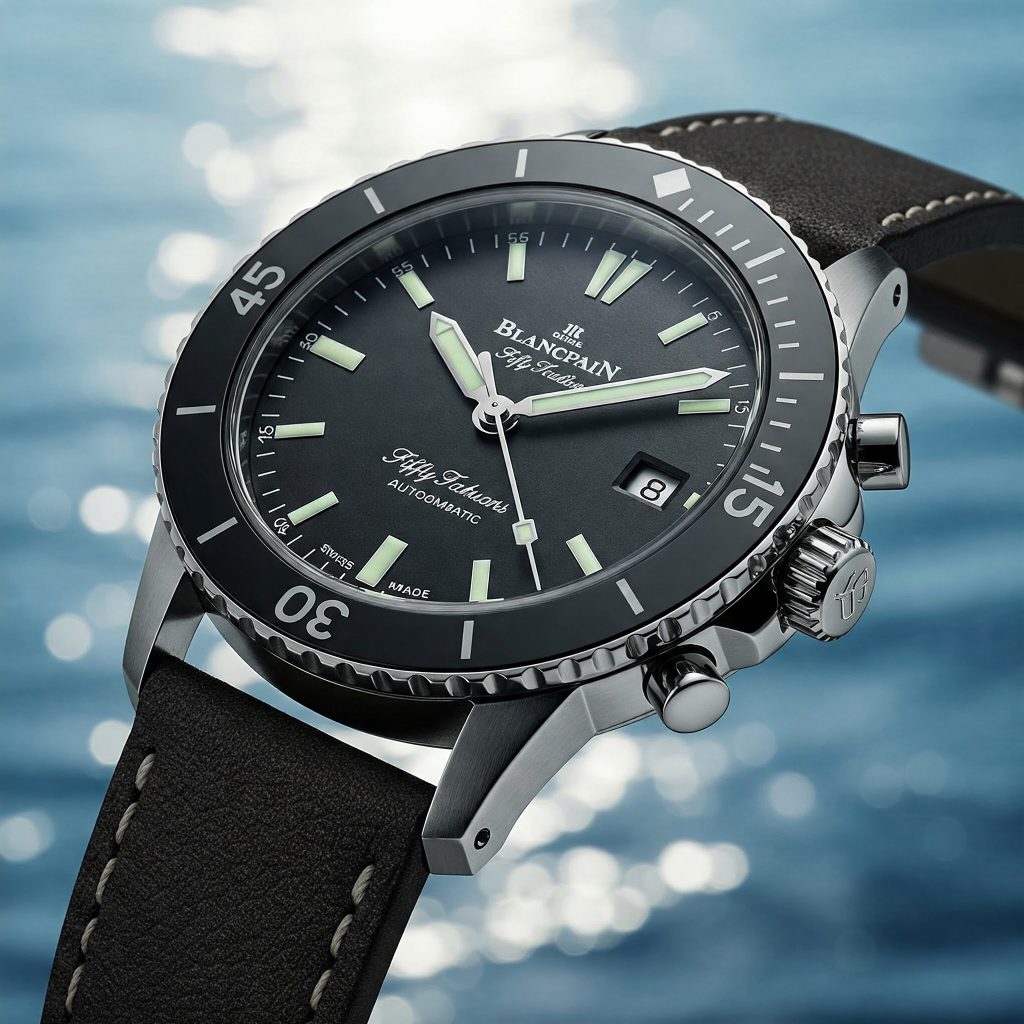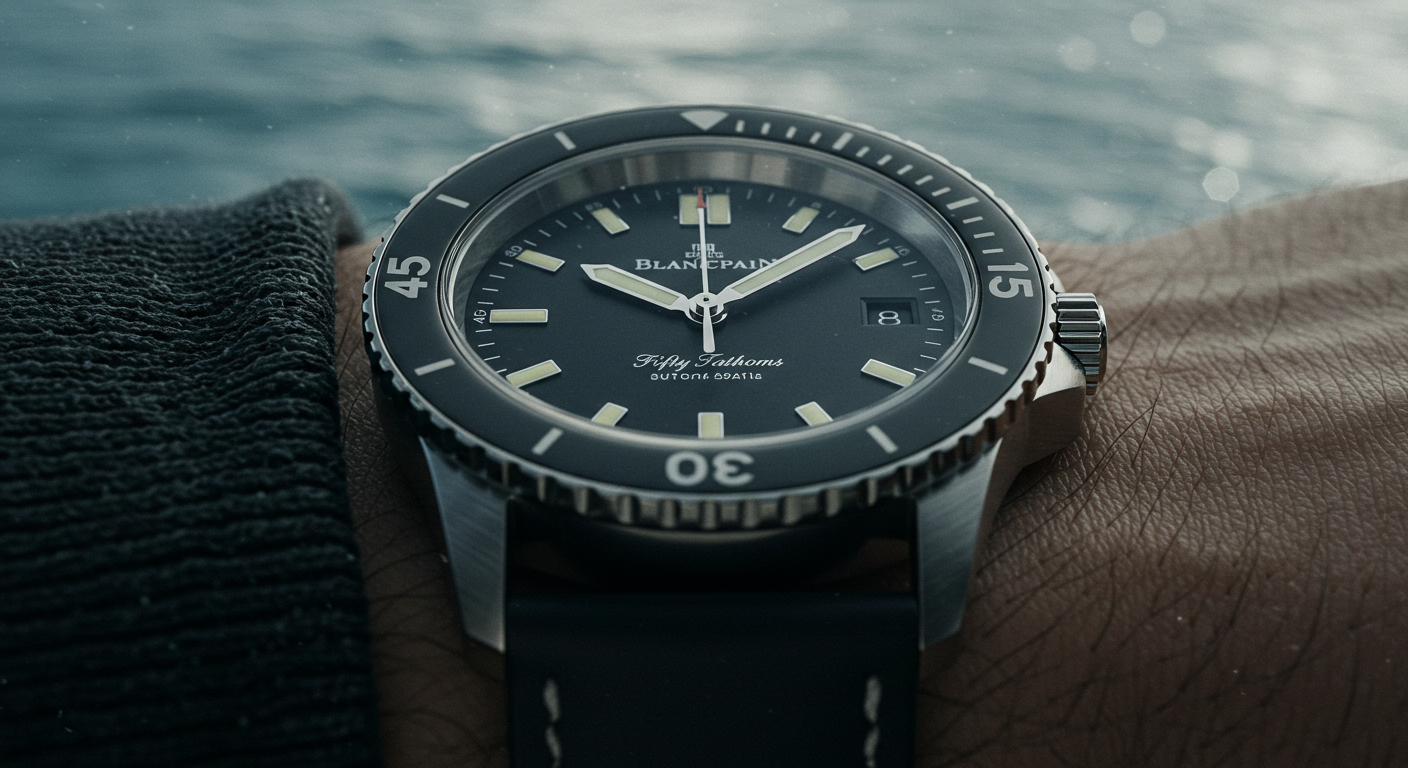Jacques-Yves Cousteau. The name evokes images of vibrant coral reefs, mysterious shipwrecks, and the boundless blue frontier. A pioneering ocean explorer, filmmaker, and conservationist, Cousteau brought the wonders of the underwater world into living rooms across the globe, inspiring generations to explore and protect the oceans. But behind the visionary leader was a man who relied on robust, dependable equipment to navigate the challenging aquatic environment. Among the essential tools on his wrist, and that of his legendary crew aboard the Calypso, was a timepiece that would become as iconic as the aqualung itself: the Blancpain Fifty Fathoms.
This article delves into the fascinating history of the Blancpain Fifty Fathoms, tracing its origins as the first true modern dive watch and exploring its indispensable role in the golden age of underwater exploration, inextricably linked with the exploits of Jacques-Yves Cousteau and his team. It’s a story of necessity, innovation, and the birth of an iconic dive watch.
The Dawn of Underwater Exploration and the Need for Reliable Time
In the mid-20th century, SCUBA diving was transitioning from a niche activity for military specialists to a burgeoning pursuit for scientists, explorers, and adventurers. While the invention of the self-contained underwater breathing apparatus (Aqualung) co-invented by Cousteau and Emile Gagnan in the early 1940s revolutionized access to the depths, divers still faced significant challenges. Chief among these was accurately monitoring bottom time – the duration spent underwater at a given depth – which is critical for preventing decompression sickness (the bends).

Surface watches were simply not built for the pressures and corrosive nature of the underwater environment. They leaked, fogged up, and their dials were often illegible in dim light. Divers desperately needed a timepiece that could withstand the immense pressure, remain waterproof, offer clear visibility, and provide a reliable way to track elapsed time during a dive.
Birth of a Legend: The Blancpain Fifty Fathoms
The Blancpain Fifty Fathoms was not born out of a marketing meeting, but out of military necessity. In the early 1950s, the French Navy’s combat swimmer unit required a reliable, robust watch for their elite divers. Captain Robert “Bob” Maloubier and Lieutenant Claude Riffaud were tasked with finding or commissioning such a timepiece. Their specifications were clear: it had to be waterproof to a significant depth, legible in low light, anti-magnetic, and crucially, have a mechanism to track dive time safely.
They approached several watch manufacturers, but most dismissed their requirements as impossible or impractical. Enter Jean-Jacques Fiechter, the CEO of Blancpain at the time, and an avid amateur diver himself. Understanding the challenges and dangers of diving firsthand, Fiechter recognized the critical need for such a tool and possessed the vision and technical expertise to create it.

Working closely with the French combat swimmers, Fiechter and Blancpain developed a prototype that met and exceeded the military’s demands. Introduced in 1953, the Blancpain Fifty Fathoms is widely regarded as the first modern dive watch. Its name refers to its water resistance rating of 50 fathoms, equivalent to approximately 91.45 meters – a remarkable depth for the time and well beyond the typical limits of recreational diving.
Revolutionary Features of the Original Fifty Fathoms
What set the original Fifty Fathoms apart and made it a game-changer for divers? Several innovative features became the standard for future dive watches:
- Superior Water Resistance: The robust case construction, featuring a double O-ring seal on the crown and a screwed case back, ensured unprecedented protection against water ingress down to 50 fathoms.
- Unidirectional Rotating Bezel: This was a crucial safety feature. The bezel, marked with a timing scale, could be rotated to align the “zero” marker with the minute hand at the start of a dive. As the dive progressed, the minute hand pointed to the elapsed time on the bezel. The bezel was designed to rotate only counter-clockwise. This was a brilliant safety measure: if the bezel were accidentally knocked, it would only indicate a longer elapsed time, thus potentially cutting a dive short rather than dangerously extending it by showing a shorter time.
- Outstanding Legibility: Large, luminous hour markers and hands ensured the time could be read clearly in the often murky conditions underwater. The dial was simple, uncluttered, and highly contrasting.
- Automatic Movement: The use of a self-winding movement was important. It meant the diver didn’t need to unscrew the crown to wind the watch, minimizing the risk of compromising the water seal before a dive.
- Anti-Magnetic Protection: Essential for maintaining accuracy in environments with potential magnetic interference.
These features, combined in one timepiece, made the Blancpain Fifty Fathoms an indispensable tool for professional and military divers.
Cousteau and the Fifty Fathoms: A Partnership Forged Underwater
It’s here that the stories of Jacques-Yves Cousteau and the Blancpain Fifty Fathoms truly intertwine. While Blancpain supplied the French Navy, the watch’s reputation for reliability quickly spread through the diving community. Jacques Cousteau, ever the pragmatist focused on dependable gear for his expeditions, recognized the Fifty Fathoms’ exceptional capabilities.
Though not a formal, paid endorsement initially, Cousteau and his team aboard the Calypso adopted the Blancpain Fifty Fathoms as their watch of choice. The watch was seen on the wrists of divers in iconic films like The Silent World (Le Monde du Silence), which won the Palme d’Or at Cannes in 1956 and the Academy Award for Best Documentary in 1957, bringing the underwater world, and the equipment used to explore it, to a global audience.
Cousteau’s implicit endorsement was incredibly powerful. Seeing the legendary explorer and his crew rely on the Fifty Fathoms for critical timing during dives in challenging, remote locations solidified its status as the ultimate professional dive watch. It wasn’t just a timepiece; it was a symbol of adventure, reliability, and exploration.
Furthermore, for the US market, the Blancpain Fifty Fathoms was distributed through various channels, including under the “Aqua-Lung” name, capitalizing on the fame of Cousteau’s co-invented breathing apparatus and his association with the sport. This further cemented the link in the public’s mind between the pioneering diver and the pioneering dive watch.
The Fifty Fathoms: An Enduring Icon of the Deep
The Blancpain Fifty Fathoms didn’t just serve the military and famous explorers; it set the standard for virtually every dive watch that followed. Its core features – the robust case, unidirectional bezel, luminous dial, and water resistance – became the blueprint for the entire genre.
Over the decades, Blancpain has continued to produce and evolve the Fifty Fathoms, maintaining its reputation as a high-performance, luxury dive watch. While modern technology has introduced dive computers, the mechanical dive watch, and particularly the Fifty Fathoms, retains a special place in the hearts of divers, collectors, and watch enthusiasts. It represents a connection to the golden age of exploration, a testament to ingenious engineering, and a symbol of reliability forged in the demanding environment of the deep sea.
The legacy of Jacques-Yves Cousteau is one of opening humanity’s eyes to the wonders and fragility of the ocean. The legacy of the Blancpain Fifty Fathoms is one of enabling that exploration safely and reliably. Their association is more than just a famous figure wearing a watch; it’s a powerful narrative of innovation meeting exploration, where an iconic dive watch was the silent, ticking partner in revealing the secrets Beneath the Waves. Today, the Blancpain Fifty Fathoms remains a revered timepiece, carrying the spirit of adventure and the pioneering soul of the man who helped make the ocean our second world.




